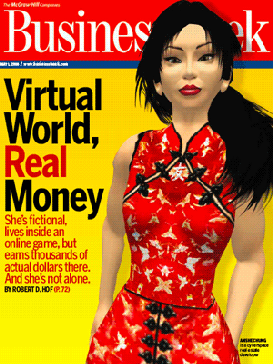
Second Life is an online multimedia platform that allows people to create an avatar for themselves and then interact with other users and user created content within a multi player online virtual world. Developed and owned by the San Francisco-based firm Linden Lab and launched on June 23, 2003, it saw rapid growth for some years and in 2013 it had approximately one million regular users. Growth eventually stabilized, and by the end of 2017 the active user count had declined to "between 800,000 and 900,000". In many ways, Second Life is similar to massively multiplayer online role-playing games; nevertheless, Linden Lab is emphatic that their creation is not a game: "There is no manufactured conflict, no set objective".

A virtual world is a computer-simulated environment which may be populated by many users who can create a personal avatar, and simultaneously and independently explore the virtual world, participate in its activities and communicate with others. These avatars can be textual, graphical representations, or live video avatars with auditory and touch sensations. Virtual worlds are closely related to mirror worlds.

In computing, an avatar is a graphical representation of a user or the user's character or persona. Avatars can be two-dimensional icons in Internet forums and other online communities, where they are also known as profile pictures, userpics, or formerly picons. Alternatively, an avatar can take the form of a three-dimensional model, as used in online worlds and video games.
A griefer or bad-faith player is a player in a multiplayer video game who deliberately and intentionally irritates and harasses other players within the game (trolling), by using aspects of the game in unintended ways in order to destroy something another player made or built, or stealing something, such as items or loot, when that is not the primary objective. A griefer derives pleasure primarily, or exclusively, from the act of annoying other users, and as such, is a particular nuisance in online gaming communities. If a bad-faith player is attempting to gain a strategic advantage, it could be considered cheating.

Philip Rosedale is an American entrepreneur who founded Linden Lab, which develops and hosts the virtual world Second Life.

Linden Research, Inc., doing business as Linden Lab, is an American technology company that is best known as the creator of Second Life.

Peter Ludlow, who also writes under the pseudonym Urizenus Sklar, is an American philosopher of language. He is noted for interdisciplinary work on the interface of linguistics and philosophy—in particular on the philosophical foundations of Noam Chomsky's theory of generative linguistics and on the foundations of the theory of meaning in linguistic semantics. He has worked on the application of analytic philosophy of language to topics in epistemology, metaphysics, and logic, among other areas.

Anshe Chung is an avatar of Ailin Graef in the online world Second Life. Referred to as the "Rockefeller of Second Life" by CNN, Graef has built an online business that engages in development, brokerage, and arbitrage of virtual land, items, and currencies. Her work has been discussed in Business Week, Fortune and Red Herring.
The virtual world Second Life has its own economy and a virtual token referred to as Linden Dollars (L$). In the SL economy, users buy from and sell to one another directly, using the Linden, which is a closed-loop virtual token for use only within the Second Life platform. Linden Dollars have no monetary value and are not redeemable for monetary value from Linden Lab. However, the presence of a currency exchange has led to the Linden Dollar being recognised as a centralized virtual currency, a fiat currency, or property. A resident with a surplus of Linden Dollars earned via a Second Life business or experiential play can offer to exchange with other users via the LindeX exchange provided by Linden Lab. This economy is independent of the price of the game, which users pay to Linden Lab, not to each other. Linden Lab reports that the Second Life economy generated US$3,596,674 in economic activity during the month of September 2005, and in September 2006 Second Life was reported to have a GDP of US$64,000,000.

Anonymous is a decentralized international activist and hacktivist collective and movement primarily known for its various cyberattacks against several governments, government institutions and government agencies, corporations and the Church of Scientology.
Avatars United was a web community for avatars of online games and virtual worlds. It was launched in March 2008 by Sweden-based Enemy Unknown and closed in October 2010. It was owned by Linden Lab, which announced its closure on September 23, 2010.
An imageboard is a type of Internet forum that focuses on the posting of images, often alongside text and discussion. The first imageboards were created in Japan as an extension of the textboard concept. These sites later inspired the creation of a number of English-language imageboards.

420chan was an anonymous imageboard founded on 20 April 2005 by freelance web developer Aubrey Cottle. According to its founder, its name was a portmanteau of 420, a slang word originating in cannabis culture but now applicable to drug culture more generally, and 4chan, another imageboard website. Discussion on the site was primarily focused around recreational drug use and wrestling, with other boards related to topics including humor and academia.

Cory Ondrejka was the Chief Technology Officer of Linden Lab, makers of Second Life. With Philip Rosedale, Ondrejka co-founded Second Life and played a significant role in the architecture of the product. After leaving Linden Lab, Ondrejka became Senior Vice President of Digital Strategy for the EMI Group until he left EMI in September 2009. He also was vice president of engineering at Facebook.

Bragg v. Linden Research, Inc., 487 F. Supp. 2d 593, was a ruling at the United States District Court for the Eastern District of Pennsylvania. The case resulted in an important early ruling on the enforceability of an online End User License Agreement (EULA) under American contract law, though it did not ultimately gain influence as a precedent. The ruling also clarified the matter of personal jurisdiction for a dispute involving a user of a website that originates in a different region.
Simulated child pornography is child pornography depicting what appear to be minors but which is produced without the direct involvement of children.
The Alphaville Herald is an online newspaper covering virtual worlds, founded by the American philosopher Peter Ludlow in 2003.
Richard P. Minsky is an American scholar of bookbinding and a book artist. He is the founder of the Center for Book Arts in New York City.

We Are Legion: The Story of the Hacktivists is a 2012 documentary film about the workings and beliefs of the self-described "hacktivist" collective, Anonymous.
Sansar is a social virtual reality platform, for Microsoft Windows only, developed by the San Francisco-based firm Linden Lab, and now owned by Sansar Inc. It launched in “creator beta” to the general public on July 31, 2017. The platform enables user-created 3D spaces where people can create and share interactive social experiences, such as playing games, watching videos, and having conversations in VR. Each participant is represented by a detailed avatar that is the graphical representation of the user including speech-driven facial animations and motion-driven body animations.













